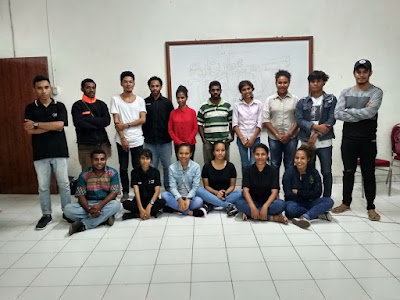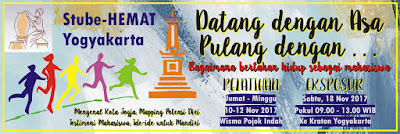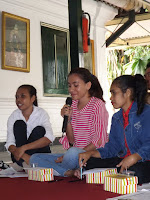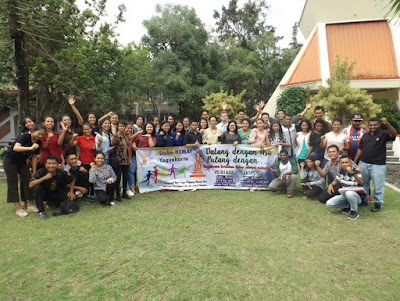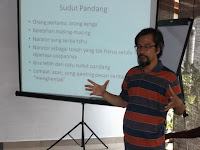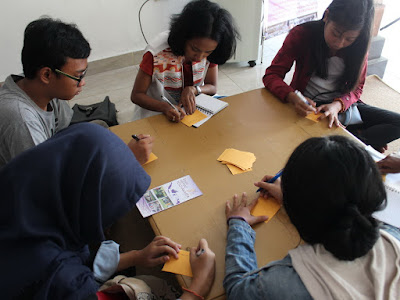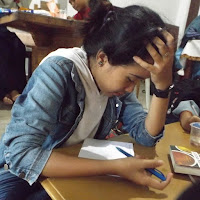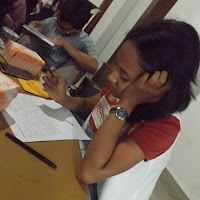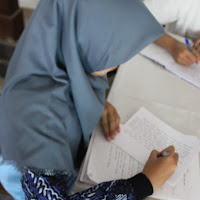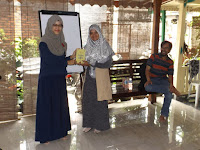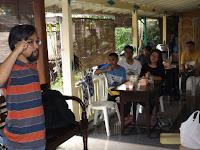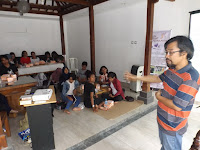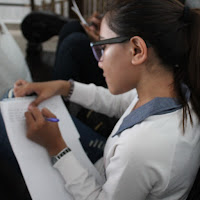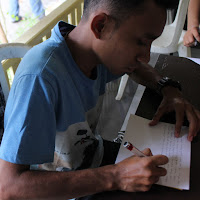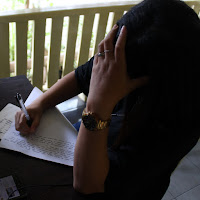2 Hours closer with Friends of UJB
Thursday, 30 November 2017by adminstube
Every training handled by Stube always has a different impression for each participant. Some areimpressed with the material delivered in everysession, and some others are impressed with facilitator of the training and Stube management. It is also experienced by the participants from Janabadra University of Yogyakarta when they followed the training of Survival Competency and at the last they want to share it with their friends.
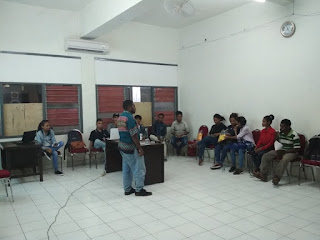 Honestly, there were severalreasons why theyfollowed the training, such as,they did not havefriends at the boarding house and they were pushed to join the program bytheir friends, like Estrela, Maria and Talia. However, there is alsoanother reason why they must follow this training asthey needed to follow it, like Hanis and Fangges. At the end of the training they admitted how they understood and got new knowledge about business and important things related with the new village regulation delivered in the last session of the training. Finally, after following the plot of training, they began to understand why they werethere. Now, Hanis has had a network already withRumah Kreatif Jogja for trading a typical bag from Maybrat Papua in Jogja and knitted bag from Jogja to Maybrat, Papua.
Honestly, there were severalreasons why theyfollowed the training, such as,they did not havefriends at the boarding house and they were pushed to join the program bytheir friends, like Estrela, Maria and Talia. However, there is alsoanother reason why they must follow this training asthey needed to follow it, like Hanis and Fangges. At the end of the training they admitted how they understood and got new knowledge about business and important things related with the new village regulation delivered in the last session of the training. Finally, after following the plot of training, they began to understand why they werethere. Now, Hanis has had a network already withRumah Kreatif Jogja for trading a typical bag from Maybrat Papua in Jogja and knitted bag from Jogja to Maybrat, Papua.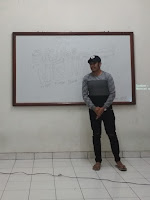
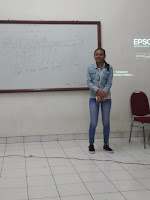 Considering the importance of material, they made a small discussion with some student of Janabadra Universityfacilitated byStudent ActivityCentre of Christian Community and some other students about business and how to survive as a student. On Friday, 17th November 2017 at Janabadra University of Yogyakarta, there were seventeen students interested in joining their follow-upactivity. The discussion was opened by Elisabeth whointroduced what Stube-HEMAT is and then Hanis, Fangges, Maria, Estrela and Talia telling about material from the training. Estrela said, “Honestly, first I felt pushed to make a question in a session, but then I thought that it was important for me to think and give opinion when I follow discussion because I am a passive one. Stube taught me to find some ideas and shared it with others. Mariaadmitted, “I learned many interesting things and I knew more another side of Jogja related withcriminal case and it made me to be more careful”.
Considering the importance of material, they made a small discussion with some student of Janabadra Universityfacilitated byStudent ActivityCentre of Christian Community and some other students about business and how to survive as a student. On Friday, 17th November 2017 at Janabadra University of Yogyakarta, there were seventeen students interested in joining their follow-upactivity. The discussion was opened by Elisabeth whointroduced what Stube-HEMAT is and then Hanis, Fangges, Maria, Estrela and Talia telling about material from the training. Estrela said, “Honestly, first I felt pushed to make a question in a session, but then I thought that it was important for me to think and give opinion when I follow discussion because I am a passive one. Stube taught me to find some ideas and shared it with others. Mariaadmitted, “I learned many interesting things and I knew more another side of Jogja related withcriminal case and it made me to be more careful”.The sharing raised curiosity to the participants andone question from Beny coming from Timor Leste, that he wanted to know whether there is a training to be a good mediator. Sarloce one of Stube team said thatStube has already facilitated student with suchtraining, to be a good mediator through Conflict Management training last September, but if he is interested in this issue and wants to learn more, oreven likes to make a small discussion and trainingmaterial, he can contact the team at Stube office.
 Elisabeth added that to be a good mediator can’t be instant because there is a process that must befollowed. The last training, Stube made a follow up how to be a good mediator. Besidestheory, the participants were also trained to make a mediation practice based on the theoretical process.
Elisabeth added that to be a good mediator can’t be instant because there is a process that must befollowed. The last training, Stube made a follow up how to be a good mediator. Besidestheory, the participants were also trained to make a mediation practice based on the theoretical process.There were still many more question to ask but the time was just limited for two hour, from 16.00–18.00 p.m, so the discussion was closed and continued by aphoto session together with all participant. They hoped that there will we other discussion.
Nothing can size us to learn, if our heart, soul and mind are asking for. If we want to be heard, we shall learn and speak intelligently. (SAP).
Obtaining the Life Meaning from Yogyakarta Palace
Monday, 20 November 2017by adminstube
Saturday, November 18, 2017 was the day that students and activists of Stube-HEMAT Yogyakarta waited. The day gave them a chance to learn about Kraton Ngayogyakarta, history and itsrole in national struggle, education, culture and life. Siti Amirul, one of the palace tourist staffswho guided the participants to Gadri Kasatriyan explained parts of the palace, like ‘bangsal Srimanganti’ a place to wait the presence of Sultan,‘bangsal Trajumas’ a place to hear the consideration of Sultan, ‘Panitrapura’ or the administration of Kraton and ‘Prabayeksa’ or ‘kedhaton’ as the main building of the palace. Although the palace is more than 200 years old, it is still used as a residence complex of the sultan until now and listed as a world heritage building by UNESCO in 1995.
KPH Yudohadiningrat and KRT Rinto Isworo welcome the group of Stube-HEMAT Yogyakartaand opened the dialogue and expressed his delight feeling for the visit. Ariani Narwastujati, the director of Stube-HEMAT expressed her gratitude for the group of students got a permission to visit and learn about Sultan's palace. Students from various backgrounds of study, ethnics and local origin feel that Yogyakarta has a good tolerance by accepting them to study in the city, of course Kraton Yogyakarta became interesting part to be known deeper.
The initiation process of the construction of the center of Ngayogyakarta was started with ‘God’s revelation’ through Prince Mangkubumi’s dream about a holy and clean place between Mount Merapi and Parangkusumo beach, located between several rivers, namely Winongo, Bedog and Progo on the west and Code, Gajahwong and Opak on the east. When the place was found, it was a jungle called Beringan, with a small village called Pacetokan. October 9, 1755 was the beginning to open the forest and build kingdom center. The construction was completed on October 7, 1756 and began to be occupied by the royal family. The date is set as the anniversary of Yogyakarta.
In the palace environment there are palace servants who work sincerely for the palace. They wear special clothes, namely'peranakan' withheadband andpractice barefootinside the palace. This means that the servants are brothers and they are living in simplicity without discrimination even having diverse backgrounds of education, religion and age.
Answering the students' curiosity about Yogyakarta and its privileges, KPH Yudohadiningrat explainedthat governor and deputy governor must be Sultan and Paku Alam who reign at that time. The history of the privilege began in 1945, Sultanate of Yogyakarta declared to join Republic of Indonesia and President Soekarno declared Yogyakarta as a Special Region through State Law no 3/1950 and completed by State Law no 13/2012. The consequence was the change of Yogyakarta from absolute monarchy to constitutional monarchy, so the Sultan as governor adjusted the period of per five years and reappointed for the next five years.
Regarding the student's question whether the Sultanmust be a man? KPH Yudohadiningrat revealed that Sultan Hamengkubuwono X want to be an example for the community as a king or sultan who has one wife. Further, there is no Kraton literature saying thatthe king must be a man, even it is found that Sultan Hamengkubuwono V wrote 'Serat Puji' saying that 'the king of the palace should be a man but if the sultan who reigns does not have sons and there is only women, then the woman is entitled to be the king.'The main point is either man or woman who has a good figure, is able to protect and brings prosperity to the community deserves to be the king.
A visit to the Sultan's Palace brought students to discover not only the buildings and symbols but also the inheritance of life values that have continued to live till now. Students studying in Yogyakartaare expected to find the values of life andactualize it in daily life to be useful for society. (TRU).
To Yogyakarta with dreams and come back home with ...
Tuesday, 14 November 2017by adminstube
To Yogyakarta with dreams and come back home with ... (filled by each student who wandered to study in Yogyakarta), became the title of 'survival' training held by Stube HEMAT on Friday-Sunday (10-12/11/2017) at Wisma Pojok Indah, Sleman. Forty-eightparticipants attended the training with aims thatstudents will have a good attitude of life, knowledge and skills to survive as a student in Yogyakarta.
Yogyakarta is known as a city of education because there are hundreds of state and private universitiesas study destination of students from various regions in Indonesia. Although Yogyakarta is known for its hospitality and comfort, it turns out that many students do not have good preparation and management for college, even facing culture shock and finding difficulties to choose activities thatmay support their study. The family's economic condition and inability to manage time affect their studies and even vulnerable to get involved in negative things, such as alcohol abuse, free sex, crime and failure to complete their studies.
At the beginning of the training, Sarloce Apang introduced Stube-HEMAT as a learning and student empowerment place, followed by Stube HEMAT Bengkulumultiplier, Yohanes Dian Alpasa who shared his experience when following Stube-HEMAT activitiesthat encouraged him to be a pioneer of Stube-HEMAT in Bengkulu. To equip participants how to survive in facing irresistible changes, Robinson P. Aritonangshared 'How to Survive Change You Didn't Ask For' which revealed tips in dealing with it.
In the next day the participants learned to know Yogyakarta delivered by Trustha Rembaka describing the history of Yogyakarta, its role in Indonesian history and various places that support student for learning. A journalist from Tribunjogja, Sulistiono was also invited to reveal the threat of drugs and free sex among students. According to police data, from January to August 2017, there were 372 people involved in drug cases and 1.078 girls gave birth, 976 of whom were unwanted pregnancies. Sulistiono advised that students always be aware of the urban lifestyle.
Testimonials of some students completed this training. Arnita Marbun, a social worker explained how she accompanied a student to stay strong and finish her study despite sexual violence. Retno Puji Astuti, a student who inspired participants for success completing her study in midwifery with cum laude, even though both parents are visually impaired. Even more amazing was Vindi Dwinantyo, even though he is blind, he doesn’t want the limitation restricts his life, even now he continue his study to Magister degree. The facilitators were really inspiring participants to be more active and creative with all their advantages.
Stephanus Benny, a magister student of psychologyGadjah Mada University guided participants to map their potencies and self-vulnerability. He explained that each study should have a clear purpose to achieve. A student is required to be independent, one thing that he/she can do is creative business. Indah Theresia offered several steps to do business according to the era and market opportunities by optimizing spare time and using belongings as modal. This session was complemented by two students’ experiences when they were in Yogyakarta. Yohanes Dian Alpasa often wrote articles and sent to media and sold newspapers and Yoel Yoga Dwianto from Lampung made organic vegetable garden and trained himself to play jimbe and opened jimbe percussion course as creative business.
In the last day, Dr. Murti Lestari, M.Si., one board member of Stube-HEMAT encouraged students to learnthe government’s village funds program and its usage, so that when they come home to their local area, they can monitor and utilize village funds forcommunity welfare. At the end of the training participants designed activities to share experiences. Hanis and his friends will hold a small discussion at Janabadra University and Maritjie and her friends will gather students from Aru islands and discuss their study in Yogyakarta.
The students were able to survive as students if they know the goal of their life, have ability to do adaptation, know his potency and always respond positively toward changes. (ELZ).
Pursuing ideas and write!
Monday, 6 November 2017by adminstube
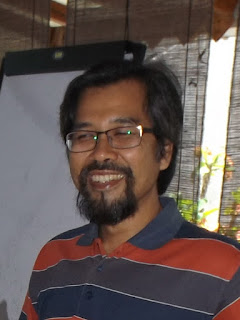 "Writing fiction is like digging a well with a needle. It is not easy anda hard work. He should have idea or inspiration, but he cannot just wait for the idea or inspiration but should seek and pursue ideas", said Achmad Munjid starting the Workshop on Writing Fiction, on Sunday, November 5, 2017 at Stube-HEMAT Yogyakarta secretariat. This was a collaboration between Stube-HEMAT Yogyakarta and team of Magister of Literature Science of Gadjah Mada University as a dedication program to community.
"Writing fiction is like digging a well with a needle. It is not easy anda hard work. He should have idea or inspiration, but he cannot just wait for the idea or inspiration but should seek and pursue ideas", said Achmad Munjid starting the Workshop on Writing Fiction, on Sunday, November 5, 2017 at Stube-HEMAT Yogyakarta secretariat. This was a collaboration between Stube-HEMAT Yogyakarta and team of Magister of Literature Science of Gadjah Mada University as a dedication program to community.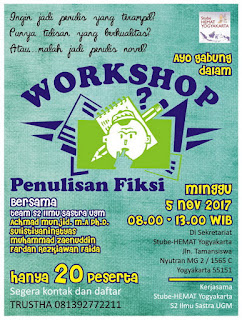 Twenty students from various campuses and regions studying in Yogyakarta and local youth as staffs of child-friendly village team attended a workshop facilitated by Achmad Munjid, M.A. Ph.D., a lecturer at Faculty of Cultural Sciences UGM, along with him wereSulistyaningtyas, Muhammad Zaenuddin and Fardan Rezkiawan Faida. Three of them were students of Magister in Literature of UGM. The facilitator felt so glad to meet participants of Stube-HEMAT Yogyakarta and appreciated Stube’s fast response to prepare the activity well although in short time and students' enthusiasm to learn how to write fiction. It was said that writing was like sport and alms. Everyone knows that these two things are good, but not everyone wants to do it. People know that writing is good, but how much effort really done by them. Writing is like riding a bike, playing a guitar or swimming, not just knowing the theory but it needs regular practice.
Twenty students from various campuses and regions studying in Yogyakarta and local youth as staffs of child-friendly village team attended a workshop facilitated by Achmad Munjid, M.A. Ph.D., a lecturer at Faculty of Cultural Sciences UGM, along with him wereSulistyaningtyas, Muhammad Zaenuddin and Fardan Rezkiawan Faida. Three of them were students of Magister in Literature of UGM. The facilitator felt so glad to meet participants of Stube-HEMAT Yogyakarta and appreciated Stube’s fast response to prepare the activity well although in short time and students' enthusiasm to learn how to write fiction. It was said that writing was like sport and alms. Everyone knows that these two things are good, but not everyone wants to do it. People know that writing is good, but how much effort really done by them. Writing is like riding a bike, playing a guitar or swimming, not just knowing the theory but it needs regular practice.
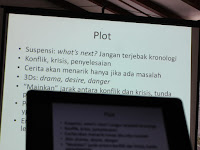 Further, there are some points noted in writing fiction,first, the story is an event that 'disturb' thoughts, conflicts, dilemmas or irregularities that occur.Second, the plot, the story contains conflicts, crises and solutions, which include 3D, drama (something attractive), desire and danger (something challenging). In this section the author needs to 'play' distance between conflict, crisis and solving, so that the reader is curious about the story. Third, related with characterization, there is keyword 'seeing is believing' that the writer should be able to present the character in the fiction story clearly so that the reader feel the real interaction with the character. Fourth, point of view of the story, the first person or third person. Each has its own advantages. Fifth, the background of the story correlates with time and place of story. It should be specific, real and historical so the reader feels something real and engages in the story although it is just fiction. Finally, the opening and closing, the author can make the opening and closing of the story gradually or shocking the readers for the effectiveness when delivering messages of ther story. Sometimes the ending of the story is a 'disturbing' ending that keeps the reader thinking about the story.
Further, there are some points noted in writing fiction,first, the story is an event that 'disturb' thoughts, conflicts, dilemmas or irregularities that occur.Second, the plot, the story contains conflicts, crises and solutions, which include 3D, drama (something attractive), desire and danger (something challenging). In this section the author needs to 'play' distance between conflict, crisis and solving, so that the reader is curious about the story. Third, related with characterization, there is keyword 'seeing is believing' that the writer should be able to present the character in the fiction story clearly so that the reader feel the real interaction with the character. Fourth, point of view of the story, the first person or third person. Each has its own advantages. Fifth, the background of the story correlates with time and place of story. It should be specific, real and historical so the reader feels something real and engages in the story although it is just fiction. Finally, the opening and closing, the author can make the opening and closing of the story gradually or shocking the readers for the effectiveness when delivering messages of ther story. Sometimes the ending of the story is a 'disturbing' ending that keeps the reader thinking about the story.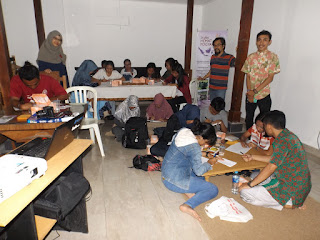 In the next session the participants practiced writing fiction. They beganto imagine an idea or inspiration, then writing the opening of a fictional story. There were some participants who wrote stories that were able to provoke the reader's curiosity, such as Anggita Getza's writing about the mystical incident and David Pamerean about the explosion in outer space.
In the next session the participants practiced writing fiction. They beganto imagine an idea or inspiration, then writing the opening of a fictional story. There were some participants who wrote stories that were able to provoke the reader's curiosity, such as Anggita Getza's writing about the mystical incident and David Pamerean about the explosion in outer space.
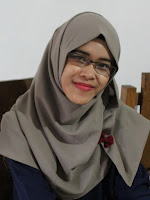 At the end of the event, Sulistyaningtyas, a young writer known as Tyas Effendi, who wrote several books, such as ‘Tentang Waktu’, ‘Catatan Musim’, ‘Life After You’ and ‘Dance for Two’ gave her books to lucky participants as appreciations. She also shared her writing experience with her perseverence to write and learn, smart to choosetrending theme for readers and learn the characteristic of publishers.
At the end of the event, Sulistyaningtyas, a young writer known as Tyas Effendi, who wrote several books, such as ‘Tentang Waktu’, ‘Catatan Musim’, ‘Life After You’ and ‘Dance for Two’ gave her books to lucky participants as appreciations. She also shared her writing experience with her perseverence to write and learn, smart to choosetrending theme for readers and learn the characteristic of publishers.
The ability to write fiction is a learning process, it needs to be continuously trained from now on. So, let us ignite motivation, pursue ideas and write. Make your fiction writing as an inspiration that enlightens reader. (TRU).
Web Archive
2024 (6) 2013 (20)
2012 (12)
2011 (2)
2010 (18)
Total: 449

